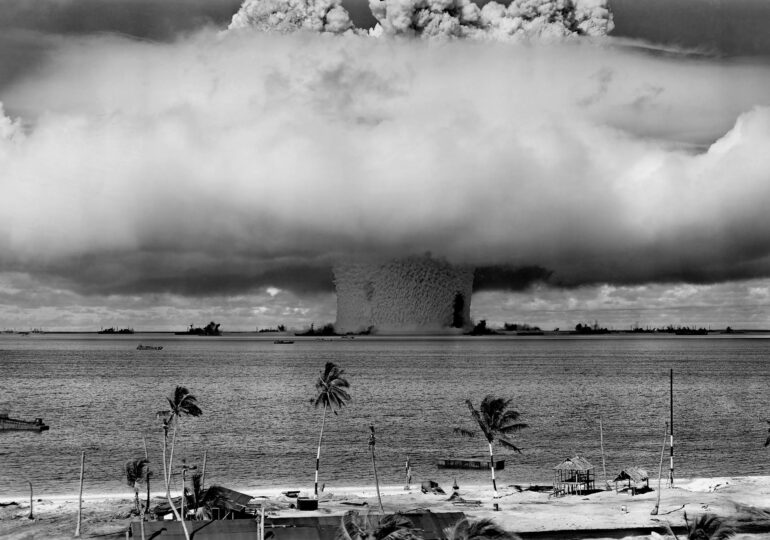Eight decades have passed since Hiroshima and Nagasaki, but the world still lives with the traces of the nuclear explosion. Over 2,000 tests conducted by the major powers from then until now have forever changed the destinies of communities that found themselves under radiation.
From Utah to Kazakhstan or the Marshall Islands, diseases, psychological trauma, and devastated lands show that the nuclear era has never ended.
Affected Generations
Raised in Salt Lake City, Utah, in the '50s and '60s, Mary Dickson was among the millions of American students taught to "duck and cover" in case of a nuclear attack.
"I remember always thinking: this won't save us from a bomb," she told CNN. At that time, she didn't know that the US was testing nuclear weapons in Nevada, right next to her state, and the radioactive clouds were heading towards the area where she lived.
Dickson was diagnosed with thyroid cancer. Her older sister died of lupus at 40, her younger sister has widespread intestinal cancer, and her nieces also have health issues. She once counted 54 people just from her childhood neighborhood who had suffered from cancer, autoimmune diseases, malformations, or miscarriages.
Doctors say that radiation exposure increases the risk of cancer proportionally to the dose received.
"Downwinders", the Unseen Victims
Those exposed in the states around the Nevada test site - Utah, Arizona, Oregon, Idaho, or Washington - became known as "downwinders" - "under the radiation wind."
"It's devastating. 'You can't imagine how many friends I had whose cancers recurred... The psychological wounds don't go away. You live your whole life with the fear that every nodule or pain means it's back,'" says Dickson, who is an activist and playwright.
A Legacy of the Cold War
The nuclear era began in 1945, with the bombs dropped on Hiroshima and Nagasaki, which instantly killed about 110,000 people and triggered the nuclear arms race. The US, USSR, UK, France, and China conducted over 2,000 tests between 1945 and 1996. India, Pakistan, and North Korea joined later.
Although international treaties have almost completely halted the practice, North Korea conducted tests in 2017. "It's not a problem of the past. Many still pay the price," warns researcher Togzhan Kassenova.
Common Stories from the Pacific to Kazakhstan
The major powers chose isolated or colonized areas for experiments: the US in Nevada and the Marshall Islands, USSR in Kazakhstan and Novaya Zemlya, UK in Australia and the Pacific, France in Algeria and French Polynesia, and China in Lop Nur. In Semipalatinsk (Kazakhstan), the USSR detonated over 450 bombs between 1949 and 1989.
"Many of my relatives were dying young, and I, being a child, didn't understand," recounts Aigerim Seitenova, a Kazakh activist. She says it took decades for the victims to break their silence.
"Our experiences are not unique. We share the same stories with French Polynesia, the Marshall Islands, Australia. We are the real experts on the humanitarian impact of nuclear weapons," says Seitenova, after her documentary on the intergenerational impact of tests in Kazakhstan was screened in Hiroshima.
Studies on Effects
Official assessments are difficult and contested. A study by the US National Cancer Institute (1997) estimated up to 212,000 additional cases of thyroid cancer from the Nevada tests (1951-1962), but subsequent reviews have reduced the estimates.
In Semipalatinsk, infant mortality and cancer mortality were higher than in the rest of Kazakhstan. In the Marshall Islands, the "Castle Bravo" test in 1954 exposed 82 people to a level of radiation that could explain up to 69% of their cancers.
7,232 Hiroshima Bombs in an Archipelago
Between 1946 and 1958, the US detonated 67 bombs in the Marshall Islands, equivalent to 7,232 bombs from Hiroshima. Five islands were partially or completely destroyed, and some areas remain contaminated nearly 70 years later.
Whole communities were relocated and never returned.
The radioactive remnants were stored under the "Runit Dome," a concrete dome that raises safety concerns today.
Insufficient Compensations
Over time, some states have offered compensations, but far from the scale of the damages. The US has paid over $1.3 billion to 27,000 "downwinders." In Kazakhstan, 1.2 million people are included in a compensation program.
France only recognized in 2010 the connection between its tests and the illnesses in Algeria and French Polynesia. The UK directs veterans to the general war pensions scheme, while organizations demand dedicated compensations.

